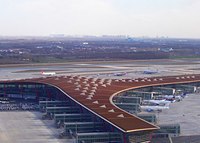Telecommunications
Main article: Telecommunications in China
China currently has the largest number of active cellphones of any country in the world, with over 1 billion users by February 2012.[361] It also has the world's largest number of internet and broadband users,[362] with over 688 million internet users as of 2016, equivalent to around half of its population.[363] The national average broadband connection speed is 9.46 MB/s, ranking China 91st in the world in terms of internet speed.[363] As of July 2013, China accounts for 24% of the world's internet-connected devices.[364]
Since 2011 China is the nation with the most installed
telecommunication bandwidth in the world. By 2014, China hosts more than
twice as much national bandwidth potential than the U.S., the
historical leader in terms of installed telecommunication bandwidth
(China: 29% versus US:13% of the global total).[365]China Telecom and China Unicom, the world's two largest broadband providers, accounted for 20% of global broadband subscribers. China Telecom alone serves more than 50 million broadband subscribers, while China Unicom serves more than 40 million.[366] Several Chinese telecommunications companies, most notably Huawei and ZTE, have been accused of spying for the Chinese military.[367]
China is developing its own satellite navigation system, dubbed Beidou, which began offering commercial navigation services across Asia in 2012,[368] and is planned to offer global coverage by 2020.[369]
Transport
The Baling River Bridge is one of the world's highest
Main article: Transport in China
Since the late 1990s, China's national road network has been significantly expanded through the creation of a network of national highways and expressways. In 2011 China's highways had reached a total length of 85,000 km (53,000 mi), making it the longest highway system in the world.[370]
In 1991, there were only six bridges across the main stretch of the
Yangtze River, which bisects the country into northern and southern
halves. By October 2014, there were 81 such bridges and tunnels.China has the world's largest market for automobiles, having surpassed the United States in both auto sales and production. Auto sales in 2009 exceeded 13.6 million[371] and may reach 40 million by 2020.[372] A side-effect of the rapid growth of China's road network has been a significant rise in traffic accidents,[373] with poorly enforced traffic laws cited as a possible cause—in 2011 alone, around 62,000 Chinese died in road accidents.[374] In urban areas, bicycles remain a common mode of transport, despite the increasing prevalence of automobiles – as of 2012, there are approximately 470 million bicycles in China.[375]
Terminal 3 of Beijing Capital International Airport is the 2nd-largest airport terminal in the world
China's high-speed rail (HSR) system started construction in the early 2000s. Today it has over 19,000 kilometers (11,806 miles) of dedicated lines alone, a length that exceeds rest of the world's high-speed rail tracks combined,[379] making it the longest HSR network in the world.[380] With an annual ridership of over 1.1 billion passengers in 2015 it is the world's busiest.[381] The network includes the Beijing–Guangzhou–Shenzhen High-Speed Railway, the single longest HSR line in the world, and the Beijing–Shanghai High-Speed Railway, which has three of longest railroad bridges in the world.[382] The HSR track network is set to reach approximately 16,000 km (9,900 mi) by 2020.[383] The Shanghai Maglev Train, which reaches 431 km/h (268 mph), is the fastest commercial train service in the world.[384]
Since 2000, the growth of rapid transit systems in Chinese cities has accelerated. As of January 2016, 26 Chinese cities have urban mass transit systems in operation and 39 more have metro systems approved[385] with a dozen more to join them by 2020.[386] The Shanghai Metro, Beijing Subway, Guangzhou Metro, Hong Kong MTR and Shenzhen Metro are among the longest and busiest in the world.
The China Railways CRH380A, an indigenous Chinese bullet train
Some 80% of China's airspace remains restricted for military use, and Chinese airlines made up eight of the 10 worst-performing Asian airlines in terms of delays.[388] China has over 2,000 river and seaports, about 130 of which are open to foreign shipping. In 2012, the Ports of Shanghai, Hong Kong, Shenzhen, Ningbo-Zhoushan, Guangzhou, Qingdao, Tianjin, Dalian ranked in the top in the world in container traffic and cargo tonnage.[389]
Water supply and sanitation
Main article: Water supply and sanitation in China
Water supply and sanitation infrastructure in China is facing challenges such as rapid urbanization, as well as water scarcity, contamination, and pollution.[390] According to data presented by the Joint Monitoring Program for Water Supply and Sanitation of WHO and UNICEF in 2015, about 36% of the rural population in China still did not have access to improved sanitation.[391] In June 2010, there were 1,519 sewage treatment plants in China and 18 plants were added each week.[392] The ongoing South–North Water Transfer Project intends to abate water shortage in the north.[393]





No comments:
Post a Comment